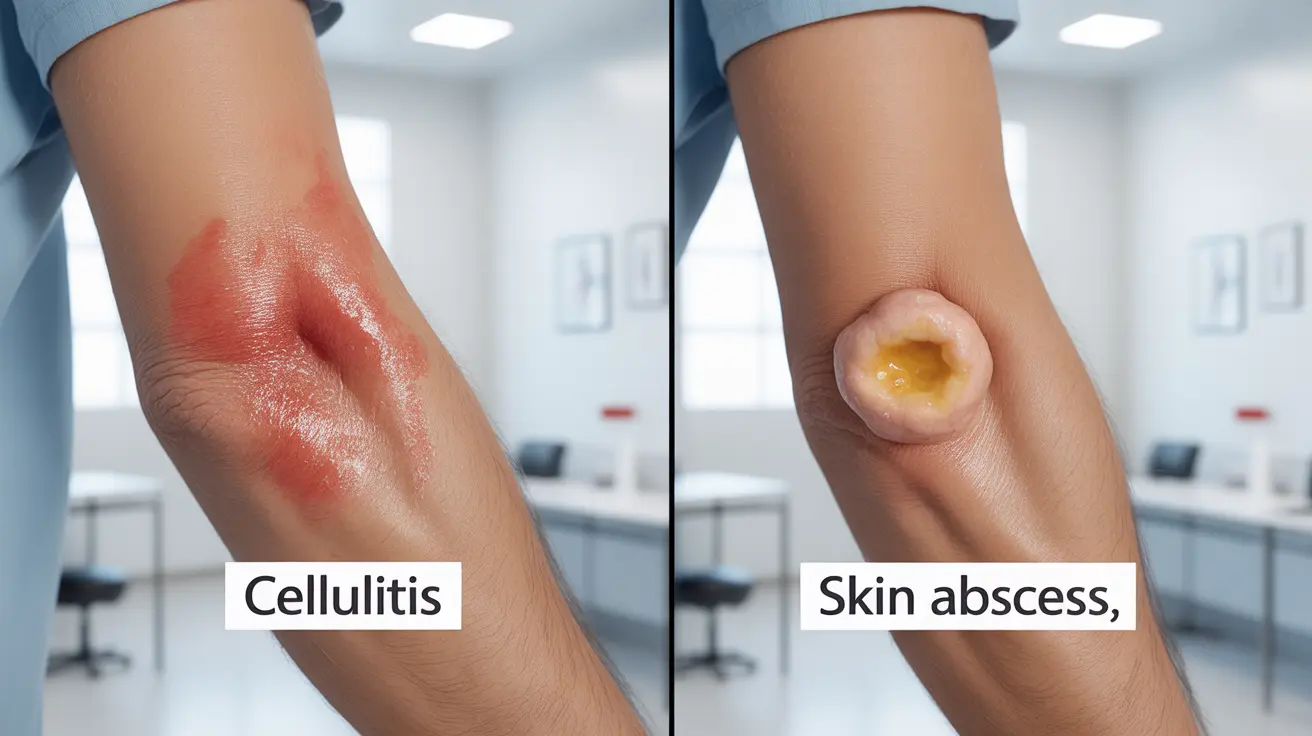Understanding the difference between cellulitis and skin abscesses is crucial for proper treatment and care. Both conditions can appear similar at first glance, but they have distinct characteristics that set them apart. This comprehensive guide will help you identify these common skin infections through their visual appearances and symptoms.
Whether you're dealing with redness, swelling, or skin tenderness, knowing how to distinguish between cellulitis and an abscess can help you seek appropriate medical care at the right time. Let's explore the key visual differences and important details about both conditions.
Visual Characteristics of Cellulitis
Cellulitis typically presents with distinct visual features that help identify this serious skin infection:
- Spreading redness and inflammation
- Poorly defined borders that expand over time
- Skin that appears stretched and glossy
- Warmth in the affected area
- General swelling without a clear center point
The affected skin in cellulitis often has a more uniform appearance compared to abscesses, without a distinct collection of pus or fluid beneath the surface.
Identifying an Abscess
Abscesses have their own unique visual characteristics that distinguish them from cellulitis:
- A raised, dome-like appearance
- Well-defined borders
- A visible collection of pus under the skin
- A white or yellowish center
- Surrounding redness that's more concentrated
Unlike cellulitis, abscesses typically form a discrete pocket of infection that may come to a head, similar to a large pimple.
Risk Factors and Causes
Understanding what leads to these infections can help with prevention and early recognition:
Common Causes of Cellulitis
- Breaks in the skin from injuries or surgery
- Chronic skin conditions
- Animal or insect bites
- Underlying medical conditions like diabetes
Common Causes of Abscesses
- Blocked oil glands or hair follicles
- Bacterial infections, particularly MRSA
- Puncture wounds
- Poor hygiene in some cases
Treatment Approaches
The treatment methods for cellulitis and abscesses differ significantly:
Cellulitis Treatment
- Oral or intravenous antibiotics
- Rest and elevation of the affected area
- Monitoring for spread of infection
- Regular wound care if applicable
Abscess Treatment
- Surgical drainage of the pus pocket
- Possible antibiotic therapy
- Wound packing in some cases
- Follow-up care to ensure proper healing
When to Seek Medical Care
Immediate medical attention is necessary if you notice:
- Rapidly spreading redness and warmth
- Fever or chills
- Severe pain or tenderness
- Red streaks extending from the affected area
- Skin that's hot to the touch
Frequently Asked Questions
- What do pictures of cellulitis typically show compared to a skin abscess?
Pictures of cellulitis typically show spreading redness with poorly defined borders and uniform swelling, while abscesses appear as raised, dome-shaped collections of pus with well-defined borders and a distinctive center point.
- How can I tell the difference between cellulitis and an abscess on my skin?
Cellulitis appears as a spreading area of redness without a central core, while an abscess forms a distinct, raised pocket of pus with more clearly defined borders. Abscesses are typically more focused and elevated compared to the diffuse spread of cellulitis.
- What are the common causes and risk factors of cellulitis and abscesses?
Cellulitis often results from bacteria entering through skin breaks, while abscesses typically form when bacteria become trapped under the skin. Risk factors include poor immune function, diabetes, obesity, and previous skin trauma.
- How is cellulitis treated differently from a skin abscess?
Cellulitis primarily requires antibiotic treatment, while abscesses typically need surgical drainage along with possible antibiotic therapy. Cellulitis treatment focuses on stopping infection spread, while abscess treatment centers on removing the collected pus.
- When should I seek medical care for red, swollen skin that might be cellulitis or an abscess?
Seek immediate medical attention if you experience fever, rapidly spreading redness, severe pain, or red streaks extending from the affected area. These symptoms can indicate a serious infection requiring prompt treatment.




